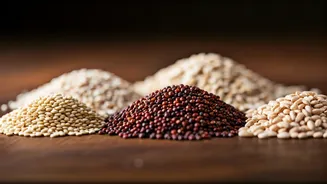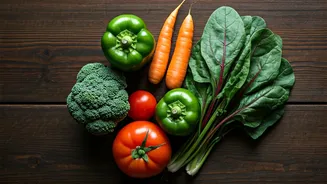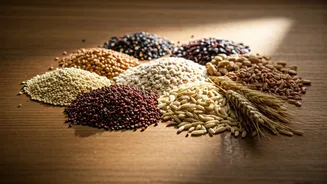Grains and Diabetes
Managing diabetes involves making careful food choices, particularly when it comes to carbohydrates. Grains, which are a primary source of carbohydrates,
significantly influence blood sugar levels. This section will elaborate on how different grains affect the body and which ones are most suitable for people with diabetes. Understanding the glycemic index (GI) and glycemic load (GL) of grains is crucial; these metrics measure how quickly a food raises blood glucose. Choosing low-GI grains helps prevent rapid blood sugar spikes, which is a key goal in diabetes management. Furthermore, the role of fiber, which aids in slowing down digestion and absorption of sugars, is important to consider. Grains rich in fiber are therefore generally favored for their ability to contribute to steady blood sugar levels and overall health. Individuals with diabetes should be aware of portion sizes, as even healthy grains can impact blood sugar if consumed in excess.
Oats: A Champion Grain
Oats are recognized as an excellent grain choice for individuals with diabetes. Their high fiber content, particularly soluble fiber like beta-glucan, is central to their benefits. Beta-glucan helps reduce the absorption of glucose and lower cholesterol levels, both of which are beneficial for people with diabetes. Oats have a low GI, which means they cause a slower and more gradual rise in blood sugar compared to high-GI foods. This characteristic makes oats an effective choice for preventing the blood sugar spikes often associated with meals. Incorporating oats into the diet can be as simple as having oatmeal for breakfast, choosing oat-based cereals, or using oats in baking. To maintain its low-GI impact, it's best to prepare oats without adding large amounts of sugar or high-sugar toppings. Opting for steel-cut or rolled oats is generally better than instant oats, as they are less processed and offer more fiber.
Barley: Versatile and Healthy
Barley is another grain that offers various health benefits, particularly for those with diabetes. Similar to oats, barley is rich in fiber, which helps regulate blood sugar levels. Barley contains both soluble and insoluble fiber; the soluble fiber plays a role in slowing down glucose absorption, while the insoluble fiber aids in digestive health. Barley has a low to moderate GI depending on how it's processed, making it a good option for people with diabetes. It can be used in numerous ways, such as in soups, salads, or as a side dish. When preparing barley, it's essential to watch portion sizes and combine it with other foods that help balance the meal, such as protein and healthy fats. Incorporating barley into the diet can provide sustained energy and support healthy digestion, contributing to a better overall health profile for those managing diabetes.
Quinoa: A Complete Protein
Quinoa is a unique grain that stands out due to its complete protein profile, containing all nine essential amino acids. While not technically a grain but a seed, quinoa is often grouped with grains in dietary discussions. It has a lower GI compared to many other grains, making it a suitable choice for managing blood sugar. Quinoa's high protein and fiber content contribute to a slower release of glucose into the bloodstream, helping to prevent sharp spikes. It's also gluten-free, which makes it appropriate for people with celiac disease or gluten sensitivity. Quinoa can be used in a variety of dishes, from salads and side dishes to breakfast bowls. It cooks quickly and has a mild flavor, making it versatile and easy to incorporate into a diabetes-friendly meal plan. When using quinoa, it is important to measure portions and combine it with other balanced components, ensuring it does not become the sole focus of the meal.
Brown Rice: Whole Grain Choice
Brown rice is a whole grain that offers more nutritional benefits compared to white rice, which has had its bran and germ removed. The bran and germ are where most of the nutrients and fiber reside. Brown rice has a lower GI than white rice and is packed with fiber, which aids in slowing down the absorption of glucose. It provides a good source of magnesium, which is important for glucose metabolism. Including brown rice in your diet can contribute to maintaining stable blood sugar levels. It’s important to watch portion sizes, as even brown rice can cause blood sugar to rise if overeaten. Consider brown rice as a base for meals, pairing it with lean proteins and vegetables. Brown rice is an excellent choice for individuals aiming to regulate their blood sugar levels because of its slower release of glucose and rich nutrient profile.
Grains to Limit
Certain grains, because of their high GI and lower fiber content, should be consumed in moderation or avoided altogether by people with diabetes. White rice, for instance, has a high GI and can cause rapid blood sugar spikes. Similarly, refined grains such as white bread, pastries, and many breakfast cereals are often low in fiber and can contribute to poor blood sugar control. Highly processed grains often lack the nutritional value of whole grains. They are quickly digested and can lead to rapid rises and falls in blood glucose levels. If you decide to consume these types of grains, portion control becomes crucial. Always pair them with fiber, protein, and healthy fats to slow down the digestion process and lessen their impact on your blood sugar. Individuals with diabetes are always advised to consult with a healthcare professional or a registered dietitian. The medical professionals are able to formulate the proper recommendations and nutritional guidelines, based on individual needs and health conditions.











